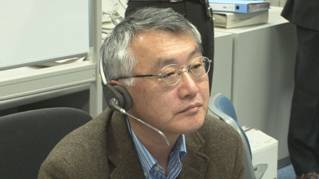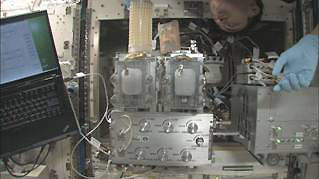This is an archive of information released in the past.
Disclaimer: It may contain broken links or outdated information. Some parts may not function in current web browsers.
*Visit https://humans-in-space.jaxa.jp/en/ for the latest information.

Experiment
- News
- Kibo Utilization Strategy
- Kibo Utilization Plan
- List of JAXA's Utilization Themes
- Experiment Facilities
- Space Environment Utilization
- Archive
"Effect of microgravity on osteoclasts and the analysis of the gravity sensing system in medaka" (Medaka osteoclast) has started on board Kibo
A life science experiment "Effect of microgravity on osteoclasts and the analysis of the gravity sensing system in medaka*" (Medaka osteoclast), which uses the Aquatic Habitat (AQH) has started on board Kibo, the Japanese Experiment Module.
*Principal Investigator (PI) Akira Kudo
Professor, Department of Biological Information, Graduate School of Bioscience and Biotechnology, Tokyo Institute of Technology.
Astronaut Hoshide started the Medaka osteoclast experiment at 6:03 a.m., Friday, October 26, 2012.
During a long-term space flight, astronauts' bone mineral density is known to decrease rapidly. The phenomenon is considered due to the disruption of balance between the amount of newly formed bone and the amount of bone absorbed into the blood. Activation of the bone resorption cells (osteoclasts) is assumed to cause the decrease of bone mineral density in space; however, the basic mechanism is still unknown.
The medaka osteoclast conducts two kinds of experiments:
The first is a long-term culture experiment which keeps young medaka, or killifish (Oryzias latipes) for two months. At certain periods after the experiment start, some medakas will be sampled from the Aquatic Habitat (AQH) aquariums and chemically fixed*. In addition, at the start and end of the culture, medaka genes are to be treated for preservation. As such, obtained samples will be returned to Earth to analyze the structure and gene expression of tissues and cells surrounding medaka's teeth and bones.
The second experiment is to launch transgenic embryo and juvenile medakas whose osteoclast or osteoblast cells specifically become fluorescent and performs on-orbit, short-term observation of such cells. The experiment started this time is the first one, and the second one is scheduled for next fiscal year.
*Chemical fixation: One of the fixation methods for biological samples. A chemical process by which cells, protein, and lipid in structures are preserved using a fixing agent such as glutaraldehyde.
By studying the osteoclast cells of medaka fish in microgravity, discovery of a novel mechanism of absorbing bones may be possible. The results are expected to be a start of the development of a new treatment for senile osteoporosis, of which a loss of cortical bone mass is seen.

Prof. Kudo monitors the proceeding from the User Operations Area at the Tsukuba Space Center (TKSC).

AQH experiment started on board Kibo
*All times are Japan Standard Time (JST)
| Copyright 2007 Japan Aerospace Exploration Agency | Site Policy |